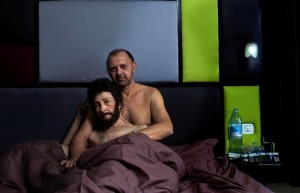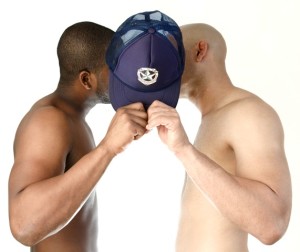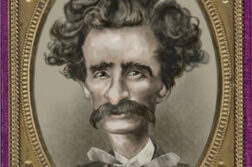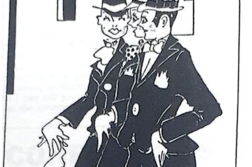ONE OF THE MOST prestigious art galleries in Havana is La Acacia, is placed in a highly touristic zone of the city. An unusual art show took place in that gallery from January 18 to February 28 of this year called Sex in the City, a collective exhibition of homoerotic Cuban art.

The title of the exhibition is in itself a provocation, invoking the HBO series of 1998–2004, which was a venture in sexual anthropology, a chronicle of the sexual adventures of four women in New York. Curated by Píter Ortega, the exhibition brought together artists from around the country. The exhibition was comprised of 32 pieces made by 25 artists, and was a blend of paintings, photographs, and video. Included were both established artists of homoerotic themes and new ones whose work has not dealt with this theme in the past.
The first hall of the gallery contained nine pieces characterized by a lyrical treatment of the theme. I want to talk about one of the pieces in particular because I have always had a certain interest in discovering ideological fissures in painted surfaces—which are sometimes not fissures but craters. This work, Enrique Rottenberg’s Contigo (2012), meaning “with you,” is a digital impression and it shows two men of about fifty years old resting joyfully in bed, naked and covered to the chest with a sheet. One man leans against the back of the bed as the other lies on the chest of his companion, inside his arms. Both of them look at the camera, but in spite of their faces’ placidity, their eyes throw off a challenge. At the right side of the painting, over a night table, it is possible to see, among other things, the remains of medicines and an open book titled Los Cuervos Del Vaticano (“the ravens of the Vatican”).
In the second hall we discover twelve pieces that speak without innuendo, making a direct reference to sex. There is among them the piece I consider the most interesting of the entire exhibition. It is named Escudo (“shield”) 2012, a digital impression on canvas, by Jorge Otero, in which two men with shaved arms and chests and very short hair, one of them white and the other tawny, are kissing behind a police cap. The social and political implications of this work may need to be pointed out to those who don’t know about the constant roundups of the so called “locas” by this repressive force.
Havana is the Cuban city with a greater proliferation of gay nightlife than any other. There are some well-known places where gay people congregate to meet and socialize. The police continue to raid these establishments and round up customers for no reason and send them to the police station to be booked for no apparent crime. The story is well known among these groups of a famous foreign filmmaker who was visiting Cuba and lived this experience firsthand.

It is also known that in an officially homophobic world like that of the Army the hypocrisy can sometimes reach stratospheric heights. There are lots of testimonies from young soldiers who have received gifts from their superiors in return for sexual favors. At the same time, these same young men can be kicked out of the Army if they are caught having sexual relations with their mates. Lots of promising military careers have been destroyed due to this policy.
The most polemical works of all are exhibited at the last hall of the gallery—polemical in the sense that they raise the question of what divides art from pornography. Both can exhibit different levels of vulgarity and, of course, we can find both categories without any vestige of “Art” in the traditional sense. Due to their visual characteristics, two works in this hall stand out as most impactful. The first is a video filmed called Iluminado (“illuminate”), by Adonis Flores, in which a man is lighting the darkness of a room. In the video we see only the thighs and legs of the man. There is a bed in front of him; at the right, a night table with a table lamp. The man is naked with his back to us and introduces us to a lamp chimney, which has a phallic form and disappears completely in his bottom. Then the room turns to darkness. The other work, La Galleta (2012; “the cookie”), by Stainless, is a series of five digital impressions on canvas that tell the story of seven naked young men masturbating around a cookie over a pedestal. They ejaculate into the cookie, and one of them eats it to the delight of the others.
There is a warning at the entrance of the Art Gallery: “This exhibition has images that can offend your sensibilities. Must be 18.” Art is irreverent, and it affects us in different ways according to our temperament. A person who consumes art knows that everything is possible when you expose yourself to its influence, but certainly something good whether the product carries us to visual gratification or to the enrichment of our souls. So, the mixture of art and eroticism is an explosive one—an explosion that doesn’t kill anybody but instead opens a pathway to follow.
Whether the artists present in Sex in the City have done anything new in an artistic sense, taking into account the vast international trove of art produced to date, the exhibit certainly has done something new in a political sense. We Cubans live at a prehistoric stage in relation to gay rights. But progress has to begin somewhere. There are now people in Cuba for whom the cause of gay rights is an essential purpose of their lives. But this is not enough, of course. For the most part GLBT people have no representation in Cuban public life. Only when the reality of gay people is recognized can we begin to counteract homophobia and move toward a recognition of gays’ human rights. This means we cannot speak eternally in a whisper but must raise our voices, if necessary, to a shout.
Francisco Castro is a Cuban filmmaker.






